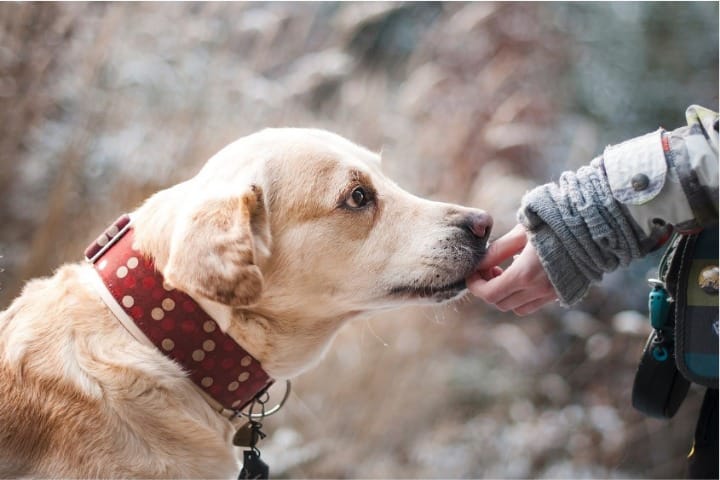Autism, a neurodevelopmental disorder characterized by impaired social interaction and communication skills, affects approximately 1 in 54 individuals in the United States alone (CDC, 2020).
While extensive research has been conducted to understand Autism in humans, the question of whether dogs be autistic remains a topic of debate. This article explores this intriguing question by examining behaviors observed in dogs, current research on canine Autism, genetic factors and breeds that may contribute to autism-like behaviors in dogs, and environmental influences.

Additionally, we will discuss management strategies and support available for exhibiting autistic dogs behaviors. It is important to note that alternative explanations for these behaviors exist and must be considered.
Furthermore, we will examine the unique bond between humans and dogs and its potential impact on emotional connection. By shedding light on this subject matter, we aim to provide valuable insights that can enhance our understanding of canine behavior and ultimately serve those who care for these remarkable animals.
Autistic Dogs Key Takeaways
By examining these aspects, we can better understand how dogs may exhibit certain behaviors reminiscent of Autism in humans.
Furthermore, by highlighting the distinctions in communication and socialization patterns between dogs and humans, we can identify unique challenges and opportunities for studying canine behavior.
Similarities between Dog Behaviors to Autistic dogs
Comparisons can be drawn between certain behaviors dogs exhibit and symptoms associated.. Many dog behavioral patterns mirror some of the hallmark symptoms observed in individuals with Autism.
For instance, repetitive behaviors are common in dogs and autistic individuals. Dogs may engage in repetitive actions such as spinning, tail chasing, or paw licking, which resemble the repetitive motor movements often displayed by people on the autism spectrum.

Additionally, autistic dogs behaviors tend to have difficulties with social interaction and communication, just like their human counterparts. They may struggle to initiate and maintain social interactions with other dogs or humans, display limited eye contact, and have difficulty understanding nonverbal cues.
These similarities suggest that shared underlying mechanisms may contribute to dog behaviors and autism symptoms in humans. Further research is needed to fully understand these connections and potential implications for canine behavior management strategies.
Differences in Communication and Socialization
Autistic dogs exhibit distinct patterns of communication and socialization, highlighting the divergence in their behavioral characteristics. While dogs and individuals with Autism may struggle with certain aspects of communication and social interaction, there are notable differences between the two.
Regarding communication, dogs primarily rely on non-verbal cues such as body language and vocalizations to convey their needs and emotions. On the other hand, autistic dogs often face challenges in understanding and using verbal language effectively.

Socialization also differs between dogs and individuals with Autism. Dogs are highly social animals that thrive on interactions with humans and other dogs. They can be trained to understand complex social hierarchies within a pack or family unit.
In contrast, individuals with Autism often struggle with social skills such as making eye contact, interpreting facial expressions, or understanding social cues.
While similarities exist between dog behaviors and autism symptoms, particularly regarding communication and socialization difficulties, it is important to recognize the unique characteristics of each group when considering canine behavior or training methods for individuals with Autism.
| Canine Behavior | Canine Training |
|---|---|
| Relies on non-verbal cues | Focuses on positive reinforcement |
| Highly sociable | Incorporates structure into training |
| Responds well to consistent routines | Uses reward-based techniques |
Table: Key aspects of canine behavior and training methods
Research on Autistic dogs
Research on canine Autism has explored the possibility of neurodevelopmental disorders in dogs, shedding light on intriguing parallels between human and canine behavior. Behavior research suggests that there may be similarities between autistic dogs traits in humans and certain behaviors exhibited by dogs.
Studies have found that some dogs with behavioral issues show characteristics similar to those observed in autistic dogs spectrum disorder (ASD), such as difficulties in communication, socialization, and repetitive behaviors.
Canine developmental disorders:
- Researchers have identified a range of developmental disorders in dogs that bear resemblance to ASD symptoms in humans.
- These include compulsive tail chasing, repetitive barking or licking, hypersensitivity to sensory stimuli, and difficulties with social interaction.
While it is essential to note that these behaviors alone do not confirm an autistic dogs diagnosis, they contribute to our understanding of potential neurodevelopmental differences among canines.
Further investigation in autistic dogs is necessary to comprehensively understand these developmental disorders and their implications for dog welfare.
Genetic Factors and Breeds
The influence of genetic factors and breed characteristics on the development of neurodevelopmental disorders in canines is an area of ongoing scientific inquiry. Research suggests that certain breeds may have a genetic predisposition to develop autism behaviors.

Studies have identified specific genes associated with social behavior and cognitive function in dogs, which may play a role in developing neurodevelopmental disorders.
Additionally, crossbreeding effects have been investigated as potential contributors to these disorders. Crossbreeding can introduce genetic variations that may increase the risk of developing autism traits in dogs.However, more research is needed to fully understand the complex interactions between genetics and breed characteristics of an autistic dogs
This knowledge will aid in identifying at-risk breeds and developing targeted interventions for affected dogs, ultimately serving both the scientific community and dog owners seeking assistance for their pets.
Environmental Influences
Understanding the impact of environmental factors on the development of neurodevelopmental disorders in canines requires a comprehensive examination of various external influences. Canine development is not solely determined by genetics, socialization, and other environmental factors.
The impact of socialization on dogs cannot be overstated, as it plays a crucial role in shaping their behavior and overall well-being.The following are three significant ways in which environmental influences can affect canine development:
Diagnosing Dogs with Autism
Diagnosing an autistic dogs requires systematically evaluating behavioral patterns and neurological markers indicative of canine neurodevelopmental disorders. Currently, ongoing research is dedicated to understanding and diagnosing in dogs.
This research aims to identify specific traits and characteristics associated with canine Autism, such as repetitive behaviors, social interaction difficulties, and sensory sensitivities.To illustrate the diagnostic process, a table can be used to outline common behavioral patterns and neurological markers observed in dogs with suspected Autism.
The table below provides an overview:
| Behavioral Patterns | Neurological Markers |
|---|---|
| Repetitive behaviors | Brain structure anomalies |
| Social interaction issues | Abnormal neurotransmitter levels |
| Sensory sensitivities | Altered brain connectivity |
By utilizing this systematic approach, veterinarians and researchers are better equipped to diagnose canine autism accurately. However, it is important to note that further studies are needed to establish standardized diagnostic criteria for this condition. Continued research will improve understanding and support for dogs with neurodevelopmental disorders.
Management and Support for Autistic Dog Behaviors
A comprehensive approach incorporating behavioral interventions, environmental modifications, and specialized training protocols is essential to support and manage exhibiting autistic dogs behaviors effectively.Canine therapy can be a valuable tool in addressing these behaviors, providing dogs with structured activities and interactions to help improve their social skills and reduce anxiety.

Behavior modification techniques such as positive reinforcement and desensitization can also reshape unwanted behaviors and teach alternative coping strategies.Environmental modifications may include creating a calm and predictable environment for the dog and minimizing triggers that may cause stress or overstimulation.
Additionally, specialized training protocols can be implemented to teach specific skills or tasks to enhance the dog’s overall well-being.By integrating these strategies into a holistic management plan, autistic dogs behaviors can receive the support they need to lead fulfilling lives.
Alternative Explanations for Autistic Dogs Behaviors
Alternative explanations for behaviors resembling those seen in Autism in canines have been proposed, shedding light on potential underlying causes of these intriguing phenomena.While it is important to consider the possibility of canine behaviors, exploring other plausible explanations is crucial.
One alternative explanation is that these behaviors could indicate various canine behavioral disorders. These disorders encompass a range of abnormal behaviors and can manifest as compulsions, phobias, aggression, or anxiety.
Another possible explanation for behaviors in dogs is canine cognitive dysfunction (CCD). CCD is akin to Alzheimer’s disease in humans and often leads to changes in behavior, memory loss, disorientation, and altered social interactions.
Understanding these alternative explanations allows for a broader perspective when evaluating and managing dogs exhibiting autism-like behaviors, emphasizing the need for thorough assessments and tailored interventions.
The Human-Dog Bond and Emotional Connection
The bond between humans and dogs is characterized by a strong emotional connection, fostering mutual understanding and communication. This bond has led to using dogs in various therapeutic settings, such as canine therapy.

Canine therapy utilizes humans’ unique emotional connection with dogs to promote healing and well-being.Dogs are known for providing comfort, reducing anxiety, and increasing social interaction. They can also be trained to perform tasks that assist individuals with disabilities or mental health conditions.
Dog training techniques enhance this bond and facilitate effective communication between humans and dogs. These techniques focus on positive reinforcement, clear communication, and consistent training.
Overall, the human-dog bond serves as a foundation for canine therapy and is essential in promoting the well-being of humans and dogs.
| Genetic Factors | Environmental Influences |
|---|---|
| Inherited traits | Early life experiences |
| Genetic mutations | Prenatal environment |
| Gene expression | Socialization |
| Epigenetic changes | Diet |
Conclusion
The possibility of being an autistic dogs spectrum remains a subject of ongoing scientific inquiry and debate. While there is limited research on this topic, some studies suggest that dogs may exhibit behaviors similar to those seen in individuals with Autism.
However, it is important to note that neurodevelopmental disorder primarily observed in humans, and its diagnosis relies heavily on communication skills and social interactions that differ between species.
By exploring genetic factors and environmental influences unique to dogs, scientists can shed light on whether dogs can experience similar conditions or if their behaviors are analogous rather than directly related to Autism. A comprehensive investigation will help enhance our understanding of human and canine neurodevelopmental disorders.
“If you can’t find the right dog for you to adopt locally, please consider adopting a dog from Bone Voyage Dog Rescue. We’ll fly with your dog to you.”

SEE ALSO:
- Why Does Dog Lick My Feet
- Barkshop: The Best Place to Shop for Your Furry Friend
- Do Dogs Wag Their Tails
- Why Do Dogs Shake? Causes, Symptoms & Treatments
Frequently Asked Questions
Can humans develop autism from their dogs?
There is currently no scientific evidence to suggest that dogs can transmit it to humans. However, there is research indicating that specially trained dogs can provide support and assistance to individuals with autism.
Can autistic dogs behaviors be trained to overcome their challenges?
Dog training techniques, such as positive reinforcement and behavior modification, can help dogs with autism-like behaviors overcome their challenges. Understanding canine behavior is crucial in tailoring training methods to suit individual dogs’ needs.
Are certain dog breeds more prone to developing autism-like behaviors?
Certain dog breeds may be more prone to exhibiting autism-like behaviors, such as repetitive movements or difficulty with social interactions. However, further research is needed to determine the specific genetic and environmental factors that contribute to these behaviors in different breeds.
How do environmental factors contribute to the development of behaviors in dogs?
Environmental factors play a significant role in shaping dog behavior, including the development of that behaviors. These influences can range from socialization experiences and training methods to the physical environment in which the dog is raised, such as exposure to toxins or traumatic events.
Is there a correlation between a strong human-dog bond and the likelihood of a dog displaying autism behaviors?
The strength of the human-dog bond has been shown to have a positive correlation with certain dog behaviors. However, it is important to note that genetics also play a significant role in shaping dog behavior.
